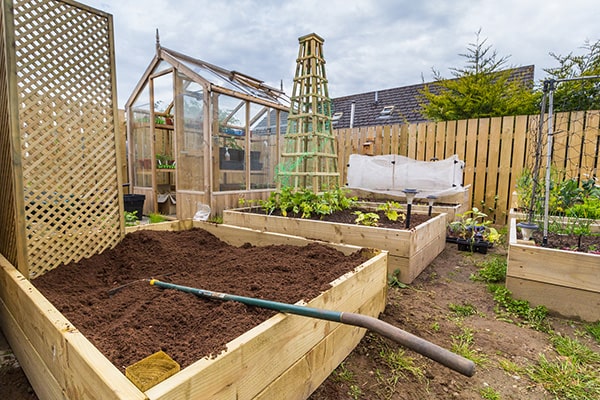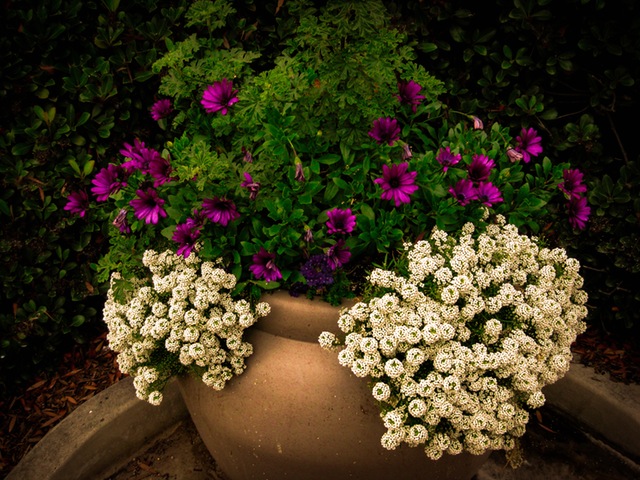
Over the years, growing your own food has become a part of everyday life for many people. Between the history of allotments continuing into today, and more and more people becoming actively interested in what goes into their food and where their food comes from, the grow your own craze is picking up traction.
Saving the planet and living sustainably is part of it, as is saving money But the key reason most people go in for edible gardening is that you can’t beat the taste of your own home-grown food. Pick it when it’s perfectly ripe and you’ll have unbeatable flavour. And if you’ve got kids, they’ll try things they’d never think to eat otherwise if they’ve grown them.
Home is where the plants are
The easiest place to start for the novice gardener is the kitchen. In fact, many people have already done this with the potted herb plants that are sold in supermarkets. Potting herbs and putting them together in something like a milk bottle carrier is a great start.[1] You can even grow tomatoes inside for a fresh salad if you want to[2]
Of course, you don’t have to stick to just herbs. Houseplants can really liven up a home with beautiful colours and living foliage to create gorgeous smells and aromas. There are plenty of varieties that do well inside, whether you’re someone who has caught the gardening bug and wants to do lots of things or someone who is forgetful and needs plants that will thrive on neglect. Consider scented geraniums on your kitchen windowsill, dracaena, peperomia or dieffenbachia[3] and if you fancy taking on something larger, try a crown of thorns or even a ponytail palm.[4]
Most plants need bright light so they do the best closer to a window, particularly in winter. They also need warmth so don’t leave them in an unheated room – but beware of overheating them near fires or radiators. This will cause them to dry out and eventually the roots will no longer be able to grow. It’s also easy to overwater houseplants, which can cause root rot. Thirsty, tropical plants are often best watered with a mist spray.[5] To avoid overwatering your plants, you can check the soil to see how dry it is, if it is still damp an inch or so down then there shouldn’t be any need to water your plants. If you’d prefer a more accurate measure, you can invest in a moisture meter which will rank the soil as wet, moist, or dry so you know when you need to add more water and when your plants can go without.

Make the most of your garden
People grow plants in their gardens for all sorts of reasons. It might be just a hobby, or they might take it more seriously – competing for a prize at a village garden show, for example. Whether you have a big or small garden, it’s important to grow things in a coherent and considered way which enables you to create something that is recognisably your own, and also help the natural environment. The bee population, for example, has been under considerable pressure in recent years and flowers can encourage them to visit your garden and help pollinate the plants, as well as providing them with a safe place to eat and reproduce.
Space is a major thing to consider in a garden. You can take a formal approach, such as planting in ordered rows, or an informal one for a more naturalistic feel[6] And you’ll probably take an approach favoured by gardeners for centuries, by creating a herbaceous border.[7] Borders can help gardens look and feel larger while keeping a variety of colour around the outside to aid aesthetic qualities.
Borders should be planned before planting. Establish how much sun your border is likely to get, and test the soil to see if it’s acidic or alkaline. These things will have an impact on the types of plants that will succeed in your border.[8]
Next, consider plants that bloom at different times of year so that you always have something interesting to look at: bulbs and tulips for spring, roses in mid-summer and dahlias for late summer,[9] fruiting plants and trees for the autumn such as raspberries and cherries, and evergreen plants such as clematis cirrhosa for the winter.[10]
Perennials are an ideal and reliable group of plants for your borders.[11] Hardy perennials like Alchemilla Mollis (Lady’s Mantle), hardy Geranium (Cranesbill) and Dianthus (Pinks) are firm favourites with generations of gardeners.
Hanging baskets also make a great way of livening up a garden. Trailing lobelias, pansies, creeping jenny and petunias are all perfect for summer, while you can try crocuses, ivy, primula and winter-flowering heathers when it gets colder.[12]
And for flexibility, don’t forget potted plants. These are self-contained so there’s no risk of spreading through the garden – strawberries, in particular, are prone to seeding if left unchecked. Tomatoes, chillies, herbs, and bedding plants all do very well in pots. You can even try growing things to sell on at a farmers’ market if you’re feeling bold.[13]

Get green-fingered with a greenhouse
If you have the space for a greenhouse, you’ll be in a great position to really broaden your gardening horizons. And you don’t even need all that much space – there are some excellent bijou greenhouses with tardis-like space, particularly a good lean-to which you can just reach inside.
The principle of the greenhouse is that it extends the growing season, both at the start and end of the year. You can plant seeds and help them germinate in more controlled conditions, protected from a late frost, and grow fruit and vegetables even when winter is coming. Start off with things like tomatoes, lettuce, cucumbers and aubergines.[14] The best things to grow are the things your outside garden will not allow – exotic, tropical plants like frangipani or vegetables and fruit – peaches and coriander are good and some people even have success with lemons and citrus fruit[15].
Don’t skimp though – it may be tempting to get a plastic greenhouse but if there’s any strong wind it may blow over, or worse suffer rips and tears. If you’re on a budget, go for second-hand and be prepared to give the glass a good clean. Tips include choosing an aluminium frame, safety-glass that won’t break if it’s hit by a football, and installing a watering system.[16]
You’ll need to stay on top of things, though. Slugs and snails are bound to be attracted to the goodies you have inside, and you may find that on cold nights your seedlings need extra care and attention – fleece or bubble wrap are both excellent solutions to a cold snap.[17]

Find yourself an allotment
Once you’ve filled your garden and got it looking nice, you might want a new project to take on – it’s time to find an allotment. You don’t have to worry about how it looks – although many people find delight in making their patch the pride of the allotment[18]. They’re perfect for fruit and vegetables and you can find yourself with a gargantuan crop before you know it.[19]
Make sure your allotment is easy to reach, whether it’s on the way back from work or a short walk or bike ride from home. Cost can be another factor, especially in some cities where there is a shortage of allotment spaces so prices can rise[20]. Make sure the allotment is big enough, but not too big for you to handle. Other allotment holders can get annoyed if they have to fend off your weeds.
Plan your allotment before planting.[21] Read up on crop rotation and check your soil acidity after a harvest to see what might do well next time. Consider planting crops that won’t spoil if you’re not there at exactly the right moment. Winter squashes, chillies, potatoes, Jerusalem artichokes, carrots, onions and garlic are all good options.[22]
You’ll need a shed to keep essential tools in: a fork and spade, soil sieve, watering can, rakes, trowels and possibly a wheelbarrow. Don’t forget your poles and planting aids as well – string to keep your lines straight and labels so that you know where everything is.[23]

Top Tips to takeaway
- Whether you’re starting a garden, a greenhouse, or an allotment, plan it out first.
- Be honest with yourself about the amount of time you have to garden or tend an allotment.
- Houseplants make an excellent taster for novice gardeners.
- Make sure you pay attention to light – whether inside or in a garden border.
- Testing the soil for acidity seems fiddly, but it’s worthwhile.
- However much space you have, you can still create a tremendous garden with fantastic plants.
Sources
[2] https://www.planetnatural.com/growing-indoors/
[3] http://www.bhg.com/gardening/houseplants/projects/easiest-houseplants-you-can-grow/
[4] http://www.bhg.com/gardening/houseplants/projects/easiest-houseplants-you-can-grow/
[5] https://www.rhs.org.uk/advice/profile?pid=290
[6] http://www.bbc.co.uk/gardening/htbg/module3/planting_styles1.shtml
[7] http://www.gardenhealth.com/how-to-plant-a-border
[8] http://blog.theenduringgardener.com/garden-design/beds-and-borders/
[9] http://www.telegraph.co.uk/gardening/9444552/Mary-Keens-fail-safe-summer-borders.html
[10] https://www.rhs.org.uk/advice/profile?PID=111
[11] http://www.daviddomoney.com/2014/04/02/how-to-create-perennial-flower-border-bed-2/
[12] https://www.rhs.org.uk/advice/profile?pid=139
[13] http://www.allotment-garden.org/gardening-information/urban-farmer-potted-plants/
[14] https://www.greenhousestores.co.uk/Greenhouse-Growing-Guide.html
[15] http://theselfsufficientliving.com/growing-vegetables-and-fruits-in-a-green-house/
[16] http://www.telegraph.co.uk/gardening/gardeningadvice/11388090/Greenhouse-guide-13-incredibly-useful-tips.html
[17] http://www.realmensow.co.uk/?p=2838
[18] http://www.telegraph.co.uk/gardening/4699817/Allotments-a-very-British-passion.html
[19] http://www.allotment-garden.org/
[20] http://www.mirror.co.uk/lifestyle/gardening/beginners-guide-to-an-allotment-439444
[21] http://www.myallotmentgarden.co.uk/starting-an-allotment/allotment-planning/
[22] https://www.theguardian.com/lifeandstyle/gardening-blog/2012/aug/29/low-maintenance-allotment-how-to
[23] http://www.telegraph.co.uk/gardening/gardeningadvice/7548208/Allotment-toolkit-guide-by-Jean-Vernon.html




